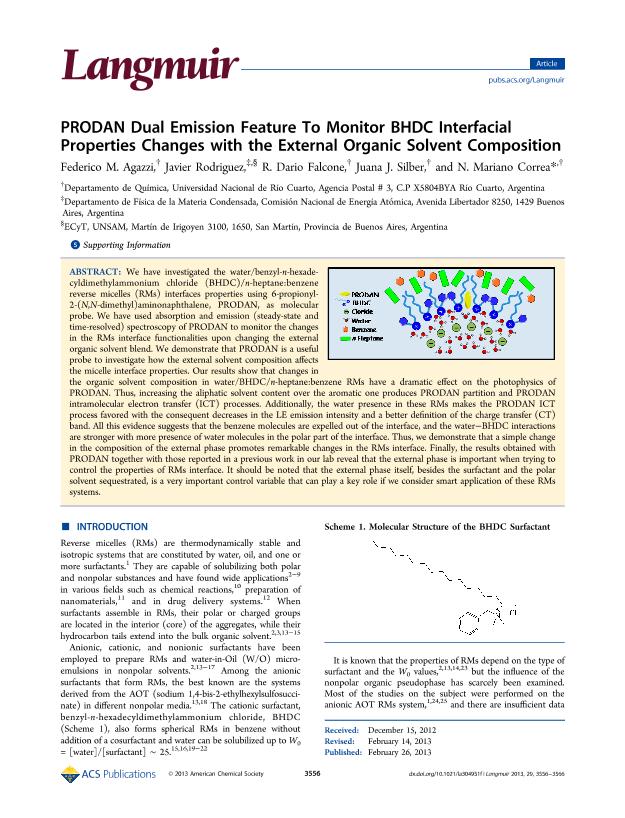Mostrar el registro sencillo del ítem
dc.contributor.author
Agazzi, Federico Martin

dc.contributor.author
Rodriguez, Javier

dc.contributor.author
Falcone, Ruben Dario

dc.contributor.author
Chessa, Juana Josefa

dc.contributor.author
Correa, Nestor Mariano

dc.date.available
2017-08-22T22:32:40Z
dc.date.issued
2013-02
dc.identifier.citation
Agazzi, Federico Martin; Rodriguez, Javier; Falcone, Ruben Dario; Chessa, Juana Josefa; Correa, Nestor Mariano; PRODAN dual emission feature to monitor BHDC interfacial properties changes with the external organic solvent composition; American Chemical Society; Langmuir; 29; 11; 2-2013; 3556-3566
dc.identifier.issn
0743-7463
dc.identifier.uri
http://hdl.handle.net/11336/22826
dc.description.abstract
We have investigated the water/benzyl-n-hexadecyldimethylammonium chloride (BHDC)/n-heptane:benzene reverse micelles (RMs) interfaces properties using 6-propionyl- 2-(N,N-dimethyl)aminonaphthalene, PRODAN, as molecular probe. We have used absorption and emission (steady-state and time-resolved) spectroscopy of PRODAN to monitor the changes in the RMs interface functionalities upon changing the external organic solvent blend. We demonstrate that PRODAN is a useful probe to investigate how the external solvent composition affects the micelle interface properties. Our results show that changes in the organic solvent composition in water/BHDC/n-heptane:benzene RMs have a dramatic effect on the photophysics of PRODAN. Thus, increasing the aliphatic solvent content over the aromatic one produces PRODAN partition and PRODAN intramolecular electron transfer (ICT) processes. Additionally, the water presence in these RMs makes the PRODAN ICT process favored with the consequent decreases in the LE emission intensity and a better definition of the charge transfer (CT) band. All this evidence suggests that the benzene molecules are expelled out of the interface, and the water−BHDC interactions are stronger with more presence of water molecules in the polar part of the interface. Thus, we demonstrate that a simple change in the composition of the external phase promotes remarkable changes in the RMs interface. Finally, the results obtained with PRODAN together with those reported in a previous work in our lab reveal that the external phase is important when trying to control the properties of RMs interface. It should be noted that the external phase itself, besides the surfactant and the polar solvent sequestrated, is a very important control variable that can play a key role if we consider smart application of these RMs systems.
dc.format
application/pdf
dc.language.iso
eng
dc.publisher
American Chemical Society

dc.rights
info:eu-repo/semantics/openAccess
dc.rights.uri
https://creativecommons.org/licenses/by-nc-sa/2.5/ar/
dc.subject
Reverse Micelles
dc.subject
Prodan
dc.subject
Bhdc Surfactant
dc.subject
Water Structure
dc.subject.classification
Otras Ciencias Químicas

dc.subject.classification
Ciencias Químicas

dc.subject.classification
CIENCIAS NATURALES Y EXACTAS

dc.title
PRODAN dual emission feature to monitor BHDC interfacial properties changes with the external organic solvent composition
dc.type
info:eu-repo/semantics/article
dc.type
info:ar-repo/semantics/artículo
dc.type
info:eu-repo/semantics/publishedVersion
dc.date.updated
2017-08-22T18:20:22Z
dc.journal.volume
29
dc.journal.number
11
dc.journal.pagination
3556-3566
dc.journal.pais
Estados Unidos

dc.journal.ciudad
Washington DC
dc.description.fil
Fil: Agazzi, Federico Martin. Universidad Nacional de Río Cuarto. Facultad de Ciencias Exactas Fisicoquímicas y Naturales. Departamento de Química; Argentina. Consejo Nacional de Investigaciones Científicas y Técnicas; Argentina
dc.description.fil
Fil: Rodriguez, Javier. Comisión Nacional de Energía Atómica; Argentina. Universidad Nacional de San Martín. Escuela de Ciencia y Tecnología; Argentina. Consejo Nacional de Investigaciones Científicas y Técnicas; Argentina
dc.description.fil
Fil: Falcone, Ruben Dario. Universidad Nacional de Río Cuarto. Facultad de Ciencias Exactas Fisicoquímicas y Naturales. Departamento de Química; Argentina. Consejo Nacional de Investigaciones Científicas y Técnicas; Argentina
dc.description.fil
Fil: Chessa, Juana Josefa. Universidad Nacional de Río Cuarto. Facultad de Ciencias Exactas Fisicoquímicas y Naturales. Departamento de Química; Argentina. Consejo Nacional de Investigaciones Científicas y Técnicas; Argentina
dc.description.fil
Fil: Correa, Nestor Mariano. Universidad Nacional de Río Cuarto. Facultad de Ciencias Exactas Fisicoquímicas y Naturales. Departamento de Química; Argentina. Consejo Nacional de Investigaciones Científicas y Técnicas; Argentina
dc.journal.title
Langmuir

dc.relation.alternativeid
info:eu-repo/semantics/altIdentifier/doi/http://dx.doi.org/10.1021/la304951f
dc.relation.alternativeid
info:eu-repo/semantics/altIdentifier/url/http://pubs.acs.org/doi/abs/10.1021/la304951f
Archivos asociados
